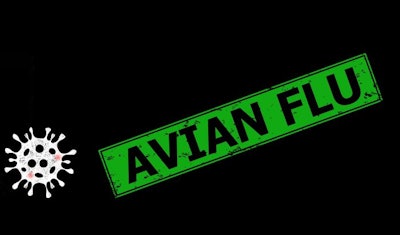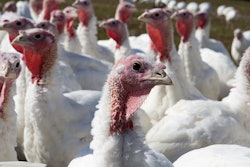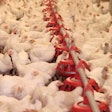
Even at this exceptionally late stage in the highly pathogenic avian influenza (HPAI) season in Europe, outbreaks linked to the H5N1 HPAI virus continue to be reported in both backyard and commercial poultry flocks.
With the geographical focus of this uptick around the English Channel and North Sea coasts, new cases are reported in commercial flocks in southwest England, the Channel Islands, France, The Netherlands, and northwestern Germany. These may be linked to on-going infections in seabirds during the current prolonged HPAI season in Europe.
As of August 20, 1,798 HPAI outbreaks have been recorded across Europe so far this year. This is based on the latest update of the Animal Disease Information System by the European Commission (EC). The total represents an increase of 21 outbreaks from the version published on July 29.
To date, one or more outbreaks have occurred in 20 European countries since the start of 2022. For comparison, this season’s figure has passed the total of 1,756 outbreaks registered with the EC by 24 European states throughout 2021.
This year, France has been the nation reporting the most outbreaks to the EC (1,350). Next come Hungary (205), the Netherlands (49), Germany (39), and Poland (35).
For the first time since March, HPAI outbreaks have been registered in Albanian poultry. These bring the nation’s total for the year so far to six.
Over the past 14 days, 10 countries across the continent from Portugal to Russia have officially registered new outbreaks in poultry with the World Organisation for Animal Health (WOAH).
Without exception, the virus serotype responsible has been identified as the H5N1 subtype.
Five nations record further outbreaks on commercial farms
Based on notifications to WOAH since August 9, France has reported the most new HPAI outbreaks in poultry to WOAH.
Of these, two affected commercial flocks in the northwestern region of Brittany in the period August 16-22. Located in the same department — Morbihan — affected were flocks of 3,500 and 43,000 poultry of unspecified type.
These bring to 1,380 the total number of French outbreaks in poultry since the start of the 2021-2022 winter. Directly impacted have been around 15.77 million commercial birds.
Over the past four weeks, the northwest German state of Lower Saxony has been experiencing a renewed spike in HPAI outbreaks in commercial flocks.
So far, six outbreaks have been confirmed to WOAH, involving more than 291,000 birds. Latest to be officially registered have involved three flocks of laying hens — each with between 14,800 and 120,000 birds — and around 22,000 meat turkeys.
In The Netherlands, HPAI continues to be detected in poultry flocks. Most recently testing positive for the HPAI virus have been 5,000 laying hens, 2,700 duck breeders, and 23,000 broiler grandparent breeders in Gelderland in the center-east of the country, and a flock of 78,000 layers and pullets in the southwestern province of Zeeland.
These bring to 58 the number of Dutch outbreaks since October of 2021, affecting almost 3.3 million poultry.
Around the end of July and start of August, HPAI virus was detected in four more poultry flocks in the United Kingdom (U.K.). All located in the southwestern English county of Devon, these involved two commercial duck flocks, and hobby/backyard birds at two other locations. Furthermore, in the Crown dependencies of the Channel Islands, HPAI was been detected in two small flocks of non-commercial birds.
Following a three-month hiatus, HPAI virus was detected again at the start of August on Spanish poultry farms.
Both of the affected premises were in the Huelva district in the southernmost region of Andalusia. While the first had around 15,200 meat turkeys, the second housed almost 36,000 broilers.
More backyard flocks infected with HPAI virus
For the remaining four countries, the latest HPAI outbreaks registered with WOAH have involved non-commercial poultry.
In Russia, HPAI virus has been detected in eight small flocks. Of these, six were in the Samara region on the Volga federal district. Rostov oblast in the Southern federal district was the location of the other two recent outbreaks.
For each of Belgium, Moldova, and Portugal, one group of backyard poultry have been reported to WOAH with HPAI.
Albania, Romania close HPAI outbreak series
In recent weeks, Albania’s veterinary authority has declared to WOAH that two earlier HPAI outbreak series have been “resolved.”
The declarations apply to a series of six outbreaks linked to the H5N8 virus serotype that affected six backyard flocks during May and June of 2021, as well as two three infections with the H5N1 virus in wild pelicans in March of this year.
Meanwhile, Romania has also officially declared the end of a series of HPAI outbreaks. These involved the H5N1 and its detection in around 90 birds — including 74 wild pelicans — between November of last year and March of 2022.
HPAI outbreaks continue in wild birds across Europe
For the year to August 20, a total of 129 outbreaks in captive birds have been registered through the system by 17 European countries. This is according to the EC system, which started reporting these cases separately in July, and the figures are still undergoing adjustment.
Of the total, France has registered the most outbreaks (39) followed by Slovenia (35), and The Netherlands (15).
Among wild birds, the EC system registered 2,356 outbreaks up to August 20. With Albania registering its first cases of the year, one or more outbreaks have now been confirmed in 30 European states in 2022.
Of the total, almost half (1,102) outbreaks have been reported by Germany, followed by the Netherlands (498). Since the end of July, the totals have increased for Denmark, Finland, France, and Germany.
Furthermore, the following eight European states have registered new HPAI cases in wild birds with WOAH over the past two weeks: Belgium, Ireland, The Netherlands, Norway, Portugal, Spain, Sweden, and the U.K.
For comparison, the EC disease system recorded a total of 2,437 HPAI outbreaks in captive and wild birds in 31 European states in the whole of 2021.
View our continuing coverage of the global avian influenza situation
.
















